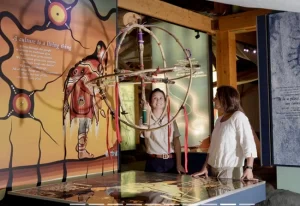Keeping the Kinoomaag Waapkong sacred in modern times

By Laurie Leclair
The Kinoomaag Waapikong, now found within the Petroglyphs Provincial Park, is surrounded by 1,555 hectares of second-growth forest, four miles northwesterly from the shore of Stony Lake on the east side of Jack’s Creek and two miles north of McGinnis Lake.
These sacred glyphs, nearly a thousand in number, were carved on a series of east-sloping crystalline limestone outcroppings. The rocks are cross-hatched by many seams and fissures ranging in size from just a few millimetres to close to half a meter, and the carvings work organically with these lines. The deepest crevice opens up to an underground stream. This water is considered sacred, especially when those listening on the surface can hear it trickling. To many people, these trickles sound like a woman whispering, and sometimes, these whispers can become teachings. Cultural Interpreter for Curve Lake First Nation and former Kinoomaage Waapkong guide, Eliza Mitigoonhs Braden-Taylor believes, “There is a reason that a lot of the glyphs are concentrated in that area.”
Like many of the traditional families on Curve Lake, other Anishinabeg knew the location of the Kinoomaage Waapkong, and managed to hold its secrets for generations. Some teachings are specific to women, others to men, some carvings relate to doodems and responsibilities and obligations that individuals, families, and clans have to each other, and some stories instruct on how to set the foundations for Bimaadiziwin. Anne MaangKwan Tayor, Indigenous Education Advisor for Peterborough, Victoria, Northumberland, and Clarington Catholic School Board, explains, “That’s one of the fundamentals of the place: You find the teaching that’s needed in that moment.” There are stories to be shared, and some to hold sacred and protected. And like the knowledge held within them, the teaching rocks were meant to be guarded and out of sight. When Anishinaabe visited the rocks, they would peel back the moss and the debris that hid them. Before leaving, these natural coverings would be replaced. For the most part, the rocks were successfully hidden from outsiders until May 1954, when a group of miners happened upon them and went public with their “discovery”.
From this moment on, tourism, preservation, and study of the Kinoomaage Waapkong became the obsession of the outside community. Academics debated over the age and significance of the carvings, archaeologists held digs around the rocks, and anthropologists mapped out each glyph, sometimes colouring them in with wax crayon or charcoal. Images were extensively photographed; impressions were taken of the carvings, and the stone itself subjected to various restorations.
In 1959, the petroglyphs site was set aside as a Type B reservation under the Public Lands Act. Once the petroglyphs were designated, the Ontario government put in a three-mile hiking trail from Stony Lake and advertised excursions to the site. A protective chain-link fence was erected sometime around 1964.
In the spring of 1968, the province of Ontario put in some rough facilities and budgeted for a staff of one maintenance person and two site interpreters, and the Kinoomaage Waapkong were officially opened to the public. Four years later, Leo Bernier, Minister of Natural Resources at the time, announced that the province had set aside Crown lands surrounding the Kinoomaage Waapkong to form the Petroglyphs Provincial Park. In 1977, Ontario’s Ministry of Natural Resources created a Master Plan for the site. The chain link fence was dismantled, and a boardwalk was constructed, encircling the glyphs.
With the popularity of the Kinoomaage Waapkong as a seasonal destination, preservationists grew concerned about the site’s vulnerability. Twelve years after the petroglyphs had been exposed to the public, the province asked the Canadian Conservation Institute (CCI) to determine the health of the rocks and to report on the degree and causes of any deterioration, as well as suggest solutions. Ultimately, the CCI advised that the best way to protect the glyphs was to enclose them.
Construction of the Petroglyphs building, which encapsulates 40 x 70 feet of rock outcropping within a seven-sided space of glass and steel, began in 1984 and opened to the public on May 7 the following year. Its first season drew 12,000 people. In the fall of 2002, a Learning Centre officially opened, and while it serves to educate the general public, the sacredness of the site remains supported. Indigenous people are invited to fast and hold sweat lodges, leave semaa, pray, and find comfort. Visitors are required to behave in a respectful manner; photography of the glyphs is prohibited.
Over the years, the action of encasing the petroglyphs, as well as the building itself, has come under heavy criticism by Indigenous groups, academics, and members of the informed public, but the building remains until a superior alternative can be found.
As the Keepers of the Kinoomaage Waapkong, Curve Lake First Nation welcomes all Anishinaabe to hold ceremony with the M’Shoomisnaan. Interested First Nations and individuals can contact the Anishinaabemaawwanjii’idiiwigamig Cultural Centre at 705-657-2758 or find out more online.


